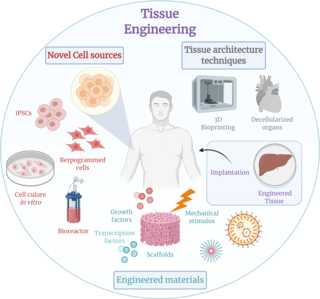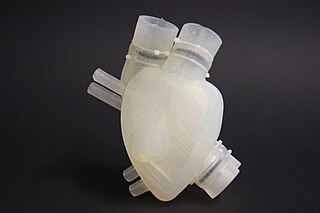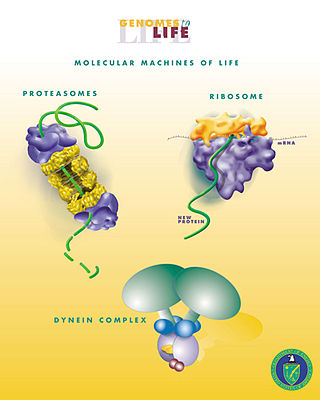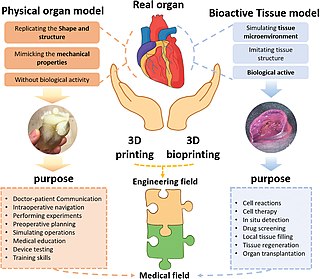Related Research Articles

Biomedical engineering (BME) or medical engineering is the application of engineering principles and design concepts to medicine and biology for healthcare applications. BME is also traditionally logical sciences to advance health care treatment, including diagnosis, monitoring, and therapy. Also included under the scope of a biomedical engineer is the management of current medical equipment in hospitals while adhering to relevant industry standards. This involves procurement, routine testing, preventive maintenance, and making equipment recommendations, a role also known as a Biomedical Equipment Technician (BMET) or as a clinical engineer.

A tendon or sinew is a tough band of dense fibrous connective tissue that connects muscle to bone. It sends the mechanical forces of muscle contraction to the skeletal system, while withstanding tension.

Tissue engineering is a biomedical engineering discipline that uses a combination of cells, engineering, materials methods, and suitable biochemical and physicochemical factors to restore, maintain, improve, or replace different types of biological tissues. Tissue engineering often involves the use of cells placed on tissue scaffolds in the formation of new viable tissue for a medical purpose, but is not limited to applications involving cells and tissue scaffolds. While it was once categorized as a sub-field of biomaterials, having grown in scope and importance, it can is considered as a field of its own.

An artificial heart valve is a one-way valve implanted into a person's heart to replace a heart valve that is not functioning properly. Artificial heart valves can be separated into three broad classes: mechanical heart valves, bioprosthetic tissue valves and engineered tissue valves.

Organ printing utilizes techniques similar to conventional 3D printing where a computer model is fed into a printer that lays down successive layers of plastics or wax until a 3D object is produced. In the case of organ printing, the material being used by the printer is a biocompatible plastic. The biocompatible plastic forms a scaffold that acts as the skeleton for the organ that is being printed. As the plastic is being laid down, it is also seeded with human cells from the patient's organ that is being printed for. After printing, the organ is transferred to an incubation chamber to give the cells time to grow. After a sufficient amount of time, the organ is implanted into the patient.

Biological engineering or bioengineering is the application of principles of biology and the tools of engineering to create usable, tangible, economically viable products. Biological engineering employs knowledge and expertise from a number of pure and applied sciences, such as mass and heat transfer, kinetics, biocatalysts, biomechanics, bioinformatics, separation and purification processes, bioreactor design, surface science, fluid mechanics, thermodynamics, and polymer science. It is used in the design of medical devices, diagnostic equipment, biocompatible materials, renewable energy, ecological engineering, agricultural engineering, process engineering and catalysis, and other areas that improve the living standards of societies.
Cardiomyoplasty is a surgical procedure in which healthy muscle from another part of the body is wrapped around the heart to provide support for the failing heart. Most often the latissimus dorsi muscle is used for this purpose. A special pacemaker is implanted to make the skeletal muscle contract. If cardiomyoplasty is successful and increased cardiac output is achieved, it usually acts as a bridging therapy, giving time for damaged myocardium to be treated in other ways, such as remodeling by cellular therapies.
Biomechanical engineering, also considered a subfield of mechanical engineering and biomedical engineering, combines principles of physics, biology, and engineering. Topics of interest in this field include biomechanics, computational mechanics, continuum mechanics, bioinstrumentation, design of implants and prostheses, etc. This is a highly multidisciplinary field, and engineers with such a background may enter related niche careers, e.g., as an ergonomics consultant, rehabilitation engineer, biomechanics researcher, and biomedical device engineer.
An organ-on-a-chip (OOC) is a multi-channel 3-D microfluidic cell culture, integrated circuit (chip) that simulates the activities, mechanics and physiological response of an entire organ or an organ system. It constitutes the subject matter of significant biomedical engineering research, more precisely in bio-MEMS. The convergence of labs-on-chips (LOCs) and cell biology has permitted the study of human physiology in an organ-specific context. By acting as a more sophisticated in vitro approximation of complex tissues than standard cell culture, they provide the potential as an alternative to animal models for drug development and toxin testing.

Three dimensional (3D) bioprinting is the utilization of 3D printing–like techniques to combine cells, growth factors, bio-inks, and biomaterials to fabricate functional structures that were traditionally used for tissue engineering applications but in recent times have seen increased interest in other applications such as biosensing, and environmental remediation. Generally, 3D bioprinting utilizes a layer-by-layer method to deposit materials known as bio-inks to create tissue-like structures that are later used in various medical and tissue engineering fields. 3D bioprinting covers a broad range of bioprinting techniques and biomaterials. Currently, bioprinting can be used to print tissue and organ models to help research drugs and potential treatments. Nonetheless, translation of bioprinted living cellular constructs into clinical application is met with several issues due to the complexity and cell number necessary to create functional organs. However, innovations span from bioprinting of extracellular matrix to mixing cells with hydrogels deposited layer by layer to produce the desired tissue. In addition, 3D bioprinting has begun to incorporate the printing of scaffolds which can be used to regenerate joints and ligaments. Apart from these, 3D bioprinting has recently been used in environmental remediation applications, including the fabrication of functional biofilms that host functional microorganisms that can facilitate pollutant removal.

Magdalena (Magda) Titirici is a Professor of Sustainable Energy Materials at Imperial College London.
Maria Teresa Alonso-Rasgado is a Professor of Mechanical Engineering and Dean for Global Engagement in the Faculty of Science and Engineering at Queen Mary University of London. She was awarded the Ohtli Award in 2016, the most significant honour of the Mexican Secretariat of Foreign Affairs. In 2019 she was awarded the Lázaro Cárdenas medal for academic excellence.
Ellen Roche is an Irish biomedical engineer and Associate Professor at MIT in the Department of Mechanical Engineering and the Institute of Medical Engineering and Science. She has contributed to heart failure prevention with her inventions, the Harvard Ventricular Assist Device (HarVAD), a soft-robotic sleeve device that goes around the heart, squeezing and twisting it to maintain the heart’s functionality, and Therepi, a reservoir that attaches directly to damaged heart tissue.
Shelly R. Peyton is an American chemical engineer who is the Armstrong Professional Development Professor in the Department of CHemical Engineering at the University of Massachusetts Amherst. Her research considers the development of biomaterials to investigate metastatic cancer and potential new therapies.
Nicole Nastaran Hashemi is an American engineer. As an associate professor at Iowa State University, Hashemi was elected a Fellow of the Royal Society of Chemistry and American Society of Mechanical Engineers.
Samira Musah is an American biomedical engineer and professor at the Duke University Pratt School of Engineering. She is known for her work in biomimetic systems, in particular for her work in developing an organ-on-a-chip model of the kidney glomerulus during her postdoctoral fellowship.
Biofabrication is a branch of biotechnology specialising in the research and development of biologically engineered processes for the automated production of biologically functional products through bioprinting or bioassembly and subsequent tissue maturation processes; as well as techniques such as directed assembly, which employs localised external stimuli guide the fabrification process; enzymatic assembly, which utilises selective biocatalysts to build macromolecular structures; and self-assembly, in which the biological material guides its own assembly according to its internal information. These processes may facilitate fabrication at the micro- and nanoscales. Biofabricated products are constructed and structurally organised with a range of biological materials including bioactive molecules, biomaterials, living cells, cell aggregates such as micro-tissues and micro-organs on chips, and hybrid cell-material constructs.
Cynthia "Cindy" Reinhart-King is an American biomedical engineer who is a University Distinguished Professor at Vanderbilt University. Her research considers cell motility and adhesion. She serves as president of the Biomedical Engineering Society.
Kristyn Simcha Masters is an American bioengineer who is professor and Chair of the Department of Bioengineering at the University of Colorado Denver. She works as Director of the Anschutz Medical Campus Center. Her research looks to create tissue-engineered models of disease, with a focus on cancer and cardiac disease.

Amrita Ahluwalia is a British pharmacologist and professor of vascular pharmacology at Queen Mary University of London. Her research considers the development of therapeutics for cardiovascular inflammation. She was awarded the WISE Research Award in 2015.
References
- ↑ "The contribution of structural components to tendon mechanics | WorldCat.org". search.worldcat.org. Retrieved 2023-12-24.
- 1 2 3 www.pageunderconstruction.co.uk. "Prof Hazel Screen". QMUL School of Engineering and Materials Science. Retrieved 2023-12-24.
- ↑ www.pageunderconstruction.co.uk. "QMUL Tendon Research". QMUL Tendon Research. Retrieved 2023-12-24.
- 1 2 Mary, Queen; London, University of. "New research identifies which cells in horses' tendons are affected by aging, leading to injury". phys.org. Retrieved 2023-12-24.
- ↑ Zamboulis, Danae E.; Marr, Neil; Lenzi, Luca; Birch, Helen L.; Screen, Hazel R. C.; Clegg, Peter D.; Thorpe, Chavaunne T. (2023-05-22). "The Interfascicular Matrix of Energy Storing Tendons Houses Heterogenous Cell Populations Disproportionately Affected by Aging". Aging and Disease: 0. doi: 10.14336/AD.2023.0425-1 . ISSN 2152-5250. PMID 37307816.
- ↑ www.pageunderconstruction.co.uk. "The Organ-on-a-Chip Technologies Network". The Organ-on-a-Chip Technologies Network. Retrieved 2023-12-24.